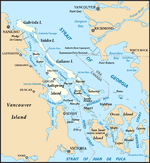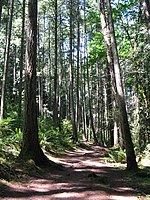Valdes Island
Caves of British ColumbiaIslands of the Gulf IslandsSpanish history in the Pacific NorthwestUnincorporated settlements in British ColumbiaUse Canadian English from January 2023 ... and 1 more
Use mdy dates from September 2023

Valdes Island is one of the Gulf Islands located in the Strait of Georgia, British Columbia, Canada. It is across Porlier Pass from Galiano Island, which lies to the southeast. It has an area of 23 square kilometres (9 square miles), and is 1.6 kilometres (1.0 mile) wide by 16 kilometres (9.9 miles) in length. The island is popular with kayakers, boaters and has historically been the site of several human settlements.
Excerpt from the Wikipedia article Valdes Island (License: CC BY-SA 3.0, Authors, Images).Valdes Island
Area G (Saltair / Gulf Islands)
Geographical coordinates (GPS) Address Nearby Places Show on map
Geographical coordinates (GPS)
| Latitude | Longitude |
|---|---|
| N 49.083333333333 ° | E -123.66666666667 ° |
Address
Area G (Saltair / Gulf Islands)
Area G (Saltair / Gulf Islands)
British Columbia, Canada
Open on Google Maps






